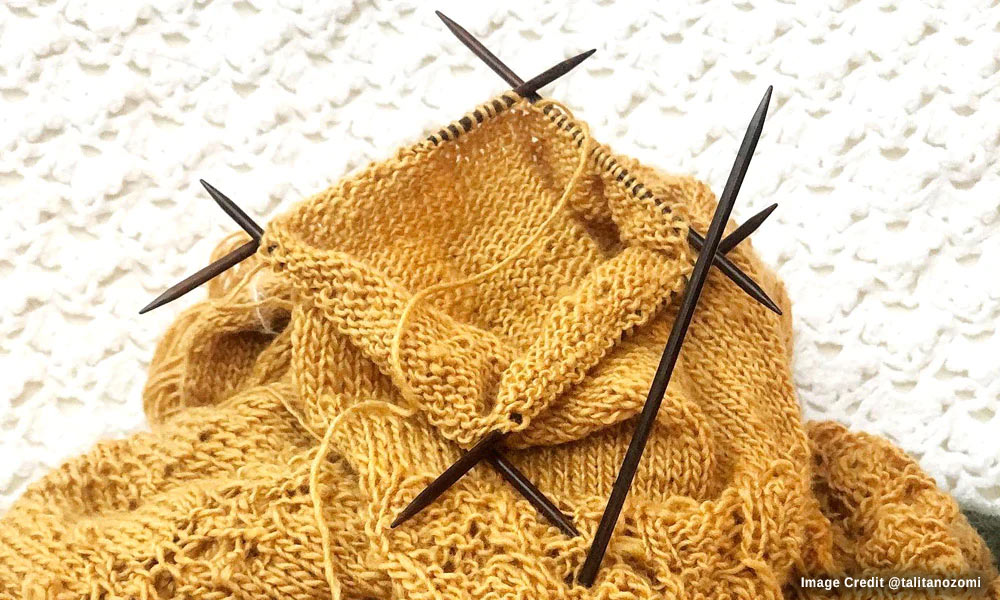
Knitting in the round means expanding your repertoire. Once you have learned the basic stitches and created some flat items, it is time to try knitting tubular objects such as socks, sleeves, hats and more. It means knitting in the round, taking up projects that can be made seamlessly, and not knitting pieces and sewing them later. There are many ways to knit in a circle, but the tools are double-pointed and circular knitting needles.
Knitters have their own preferences when choosing the knitting needles. Oftentimes a pattern recommends the needle size and yarn weight while leaving the choice of the knitting needle to the knitter. Also, it is always suggested to keep options open and learn circular knitting on both double-pointed needles (DPNs) and circular needles. So, if you are looking to knit in the round, we will take you through the methods and steps in this blog post.
Knitting circular with Double Pointed Needles
Let’s start with the double pointed needles (DPNs). These needles have been the oldest method to knit in a round. They are usually available in a set of four or five needles with all needles working together. Knitting with DPNs is practical for even the smallest circumference projects, such as hats, socks, baby booties, and the fingers of a glove. Managing the multiple needles is a challenge, but with time and practice, who knows it might become your favorite option to knit in the round.

Our previous blog on how to knit with double-pointed needles takes you step-by-step through the process. In brief, you need to join the needles in a triangle with three DPNs or a square with four DPNs, while the extra needle helps you knit or purl and stitch according to your pattern.
Knitting in a circle with Circular Needles
Circular knitting needles, be it fixed or interchangeable can be used to knit in the round. The choice of cords is important for any circular knitting project. You cannot choose small cords that don’t accommodate the stitches or a cord length that makes it a hassle to work with. While the cord lengths allow taking up huge circular projects, thanks to the invention of the Magic Loop, even knitting very small tubular items is possible if the cord is flexible enough.
Casting stitches on circular needles is no different from others. Use the cast-on method you prefer on one of the two needles of the circulars. As the needle fills with stitches, move them to the cord to make room. Keep the cast stitches loose, neat, and in the same direction. If you have a tendency to cast on too tight or too loose, then it might be an idea to cast on to a needle one size larger than what you want to knit with, and then transfer the stitches to the correct needle size. While the cast-on method remains the same there are different ways to knit in the round.
The popular method is to knit stitches according to a pattern round by round. A stitch marker is especially useful as these needles have no ends to remind the end of your round. In this method
The Magic Loop technique of knitting in the round requires a set of circular needles with extra-long cords in lengths between 36″ or even 48″. This method assists in knitting even the smallest circumferences. Cast on your required number of stitches and push them down to the middle of the cord. Divide the number of stitches in half and fold the cable in half. Half of your stitches are now on one side, the other half on the other side of that same cord. Now pull on the cord between the two middle stitches and pull it out until you have half of the stitches on your left and the other half on your right-hand needle. With the cord pointing to your left, the working yarn will hang from the back needle. Pull the yarn on the needle that is holding these back stitches and let these stitches glide back on the working yarn.

Now you can knit the stitches on your front needle. When completing the half-round you just slide the group of stitches back to their respective needle tip and continue. Before knitting the first round, just make sure that your stitches are not twisted. Also, use stitch markers to help keep track of your rounds at the point above the yarn tail.
After knitting several rounds, you can see a seamless tube take shape. The Magic Loop technique is particularly amazing for seamless, tubular projects as small as baby socks or sleeves. Besides knitting in a circle, there are other reasons to knit with circular needles, which we have discussed in our previous blog.
While knitting in a circle there is no compulsion to stick to one set or pair of needles. You can start with circular needles and switch to DPNs and vice versa. So, whether you prefer the double-pointed needles or the circulars, Lantern Moon offers premium knitting needles that offer a luxury experience. Handcrafted from ebony wood the needles have a smooth silk finish that works with all kinds of fibers. Try them out and you will discover the joy of working with ebony as well as knitting in a circle!
